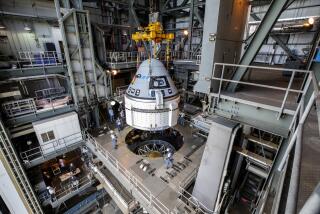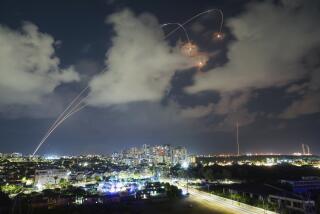Pentagon skips tests on key component of U.S.-based missile defense system
Reporting from Washington — Against the advice of its own panel of outside experts, the U.S. Missile Defense Agency is forgoing tests meant to ensure that a critical component of the nation’s homeland missile defense system will work as intended.
The tests that are being skipped would evaluate the reliability of small motors designed to help keep rocket interceptors on course as they fly toward incoming warheads.
NEWSLETTER: Get the day’s top headlines from Editor Davan Maharaj >>
The components, called alternate divert thrusters, are vital to the high-precision guidance required to intercept and destroy an enemy warhead traveling at supersonic speed – a feat likened to hitting one speeding bullet with another.
The interceptors, deployed in underground silos at Vandenberg Air Force Base in Santa Barbara County and at Ft. Greely, Alaska, are the backbone of the Ground-based Midcourse Defense system (GMD) – the nation’s main defense against a sneak attack by North Korea or Iran.
The interceptors are multi-stage rockets, each with a 5-foot-long “kill vehicle” at its tip. The 150-pound kill vehicle is designed to separate from its rocket in space, fly independently at 4 miles per second and crash into an enemy warhead, destroying it.
The performance of the divert thrusters, which are supposed to keep the kill vehicles on course during their final approach to their targets, has been a source of concern for several years. In response, the Missile Defense Agency oversaw development of a new and supposedly better version, the alternate divert thruster.
An outside panel of experts privately advised the agency to put the alternate divert thrusters through “hot fire” testing, in which they would be revved up on the ground to see whether they burned smoothly and delivered adequate propulsion.
But in order to stay on schedule for a planned expansion of the GMD system, none of the 40 thrusters that are being installed on 10 new interceptors will undergo hot-fire testing, government officials told the Los Angeles Times.
Forgoing the tests “increases the risk for reliability issues going undetected,” according to a newly released report by the U.S. Government Accountability Office. The report says that such testing “verifies proper performance and workmanship.”
Based on a commitment made three years ago by the Obama administration, the missile agency is moving to expand the number of interceptors from 30 to 44 by the end of 2017.
See the most-read stories this hour >>
There are now four at Vandenberg Air Force Base and 26 at Ft. Greely. According to a Missile Defense Agency spokesman, the total will reach 37 by the end of this year and 44 by the end of 2017. All of the new interceptors are going to Ft. Greely.
The GAO report, dated Feb. 17 and prepared for members of Congress, says the missile agency “has made progress” toward fielding more interceptors. But the report says the agency is “relying on a highly optimistic, aggressive schedule that overlaps development and testing with production activities, compromises reliability [and] extends risk to the warfighter.”
The missile agency commissioned the panel of outside experts in 2013 to “identify design, reliability, manufacturing [and] test process improvements to enhance the reliability” of the interceptors, according to agency documents.
The experts recommended in March 2014 that the agency conduct hot-fire testing on each of the alternate thrusters — or on a sample of those that were to be deployed, according to officials familiar with the matter.
The experts’ recommendation regarding the thrusters is mentioned in the GAO report. Their complete assessment of the interceptor fleet has not been made public.
The missile agency, in written comments to The Times, said it “does not agree with the GAO’s conclusion” that forgoing the hot-fire testing compromises the system’s reliability. The agency said it “has assessed it is not necessary to hot fire” each thruster “prior to emplacement.”
The agency said “a very thorough series” of hot-fire tests was completed in May 2015 on 14 experimental thrusters— components made for design purposes that will not be put into the arsenal.
The agency also said that alternate divert thrusters were used on a test rocket fired in January, and that technicians are reviewing data from that flight to determine how the components performed.
The thrusters will be evaluated again in an exercise later this year in which a rocket will attempt to intercept a mock warhead, the agency said.
But the agency acknowledged that none of the thrusters it has subjected to hot-fire testing “will be installed on fleet interceptors’’ deployed as part of the GMD system.
GAO analyst Cristina Chaplain, author of the recent report, underlined the point:
“There’s not going to be any hot-fire testing of the individual thrusters that are being produced for integration into the kill vehicles,” she said in an interview.
Chaplain said the hot-fire testing of experimental models “does not give you much insight into whether” the thrusters produced for integration into the nation’s arsenal will be “free from workmanship or quality problems.”
The GMD system is designed to repel a “limited” missile attack by a non-superpower adversary such as Iran or North Korea. The nation’s defense against a massive nuclear assault by Russia or China still relies on “mutually assured destruction,” the Cold War notion that neither country would strike first for fear of a devastating counterattack.
GMD’s roots go back to the Clinton administration, when concern began to mount over the spread of missile technology. In 2002, President Bush ordered “an initial set of missile defense capabilities” to be put in place within two years.
To accelerate deployment, then-Defense Secretary Donald H. Rumsfeld exempted the missile agency from the Pentagon’s standard procurement rules and testing standards.
Engineers trace the GMD system’s difficulties to the breakneck pace at which components were produced and fielded. In precisely scripted flight tests above the Pacific, interceptors have failed to hit mock enemy warheads about half the time.
The new GAO report concludes that the missile agency’s flight testing has been “insufficient to demonstrate that an operationally useful defense capability exists.”
The system has cost taxpayers more than $40 billion to date.
Some serious problems have been traced to the kill vehicles and their intricate electronic components.
In a December 2010 flight test, technicians concluded that vibrations within the kill vehicle disrupted its sensitive guidance system, preventing it from hitting the target missile. In three other tests, most recently in July 2013, the kill vehicle failed to separate from its boost rocket.
The undersecretary of Defense for acquisition, technology and logistics, Frank Kendall III, has attributed the problems largely to the hurried schedule.
“The root cause was a desire to field these things very quickly and very cheaply,’’ Kendall told a defense conference in early 2014, adding, “We are seeing a lot of bad engineering, frankly, and it was because there was a rush.’’
Divert thrusters were developed to help address problems observed during flight tests. But performance issues emerged in ground testing of the first thrusters, prompting development of the alternate thrusters.
A GAO report last May revealed that the missile agency — to keep pace with the scheduled expansion of the interceptor fleet – chose to equip eight new kill vehicles with the earlier, deficient thrusters.
The GAO recommended then that the agency delay putting those eight kill vehicles in the silos until the alternate divert thrusters were ready. The missile agency did not follow the advice.
In written remarks last June to some members of Congress and their staffs, Vice Adm. James D. Syring, director of the missile agency, defended the decision. He said technicians installed software “to mitigate performance issues identified with the original thruster.”
Syring added: “Delivering the eight new interceptors provides the warfighter with significant additional capability … earlier than waiting for the alternate divert thrusters.’’
Philip E. Coyle III, an engineer who formerly headed the Pentagon’s operational testing office, said that the missile agency is inviting unnecessary risk by scrapping the recommended hot-fire testing.
The approach, Coyle said, conjures “the old saying, ‘Why is there never enough time to do it right—but always enough time to do it over?’’’
Twitter: DWillmanNews
MORE MISSILE DEFENSE
Serious flaws revealed in U.S. anti-missile nuclear defense against North Korea
How a $2.7 billion air-defense system became a ‘zombie’ program
High-level support saved radar system from the ax
More to Read
Sign up for Essential California
The most important California stories and recommendations in your inbox every morning.
You may occasionally receive promotional content from the Los Angeles Times.











